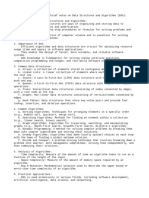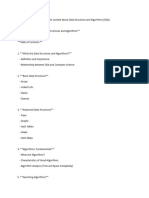0% found this document useful (0 votes)
24 views2 pagesClass Notes
This document provides quick notes on Data Structures and Algorithms (DSA), covering key concepts such as arrays, linked lists, stacks, queues, trees, graphs, sorting algorithms, dynamic programming, and complexity analysis. It outlines the characteristics, operations, and common algorithms associated with each data structure. Additionally, it includes a brief overview of time and space complexity considerations.
Uploaded by
DishaCopyright
© © All Rights Reserved
We take content rights seriously. If you suspect this is your content, claim it here.
Available Formats
Download as PDF, TXT or read online on Scribd
0% found this document useful (0 votes)
24 views2 pagesClass Notes
This document provides quick notes on Data Structures and Algorithms (DSA), covering key concepts such as arrays, linked lists, stacks, queues, trees, graphs, sorting algorithms, dynamic programming, and complexity analysis. It outlines the characteristics, operations, and common algorithms associated with each data structure. Additionally, it includes a brief overview of time and space complexity considerations.
Uploaded by
DishaCopyright
© © All Rights Reserved
We take content rights seriously. If you suspect this is your content, claim it here.
Available Formats
Download as PDF, TXT or read online on Scribd
/ 2


























































